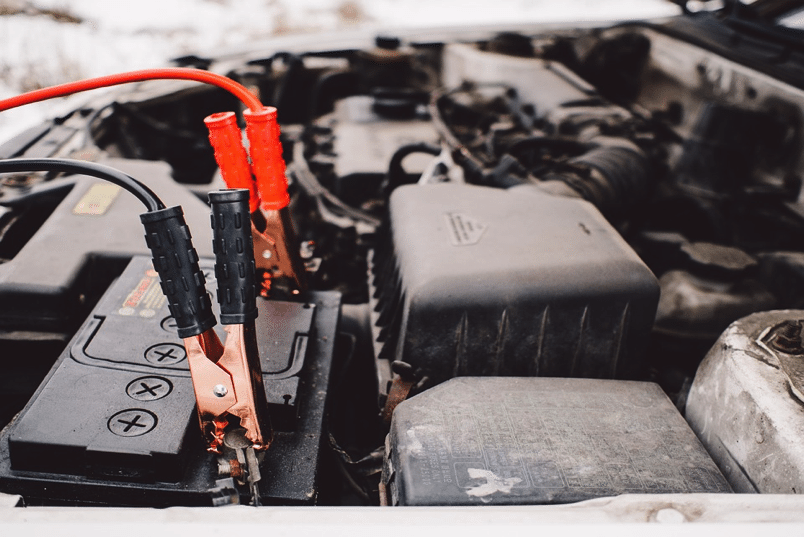
SHOP for TIRES
Tips for Maintaining Your Car Battery

When thinking about car maintenance, most people neglect the battery. Temperature, humidity and other factors can affect the lifespan of a car battery. Most batteries last for an average of four years, but under ideal conditions, a battery could last as long as six years.
Temperature extremes and frequent short trips strain the battery and shorten its life because it never achieves its full charge. Combining errands will help maximize the charge of a battery.
Maintaining your battery and keeping it charged will extend its life and its performance. To help increase the life of your battery, turn off your lights and other accessories when the car is not in use.
How a Battery Works
A car battery has six cells made up of a lead plate, a lead dioxide plate, and a sulfuric acid electrolyte solution. A chemical reaction between the three parts generates electricity, changing the elements of your battery. Electricity flows out of the posts into the engine to run your car. An electric current sent into the battery reverses the chemical reaction, charging the battery for future use.
Safety First
Before beginning any battery maintenance, remember safety procedures for handling dangerous chemicals and electricity. Do not work on the battery while it is plugged into the car. Wear safety glasses, rubber gloves, and long sleeves to protect against chemical burns from the sulfuric acid.
Visually Inspect Your battery
Check the posts for corrosion, which is a crust-like discoloration on the battery terminal and cables. Signs of corrosion mean your battery is no longer working as well as it should. Look for cracks, leaks, bulging, or any other deformities in the battery's housing. Secure the hold-down bar which ensures your battery is seated snugly and minimizes vibration.
Clean Up Corrosion
There are two DIY methods to removing corrosion from your battery. Mix water and baking soda into a solution. Apply the paste to the battery terminal and the cables. Once it is finished bubbling, scrub the terminal with a toothbrush or a wire brush and rinse off the paste with water.
The second method uses Coca-Cola as a cleaning solution. Take 12-oz can of Coke, and pour it evenly over the battery terminals and the cables. If necessary, scrub with a toothbrush or a wire brush.
You can also purchase battery cleaning spray specifically designed to clean up corrosion. Simply follow the instructions on the container.
Check the Fluid Levels: Opening the Battery

Since batteries use a solution of acid and electrolytes to generate electricity, the battery won't function if the solution isn't right. Over time, water in the solution evaporates, and the solution level slowly dwindles. When it gets too low, the battery stops working.
Some batteries have easily accessible caps, which makes checking the fluid level a quick and easy process. Clean the surface of the battery, first, to prevent dirt falling into the battery solution. Take a flathead screwdriver and gently pry the battery cell cover to remove it. Be very careful because battery acid can burn through your skin, your clothes, and your car's paint.
Check the Fluid Levels: Filling the Battery
When you look inside your battery wells, you should see the electrolyte solution and the metal plates. In a properly filled battery, the electrolyte solution will be about a half-inch above the top of the plates. There is an easy way to tell if the battery is completely full. When the solution level reaches the bottom of the filler tube, you will see a meniscus, or curved-shaped waterline, develop.
If the solution level is low, fill the battery well with distilled water, which you can buy at any grocery store. Do not use tap water, because the minerals in the tap water will harm your battery. Use a battery filler, which is a long tube with a bulb at the top to replenish your battery cells.
Test the Charge of the Battery
To test the electrolyte in each cell, use a hydrometer. Squeeze the ball on the hydrometer and draw the solution into the tester. Record the reading before squirting the solution back into the same cell. A fully charged battery should have a reading of 1.265 or higher. If the reading is low, around 1.200, the battery will need to be recharged. This can be completed at home with jumper cables and a fully-charged vehicle or at your local car repair shop.
Seek a Professional
If your battery is properly maintained and charged, but your car still doesn't start, there may be a problem with your other systems. Take your vehicle to a reputable auto shop for a starting and charging system check.
